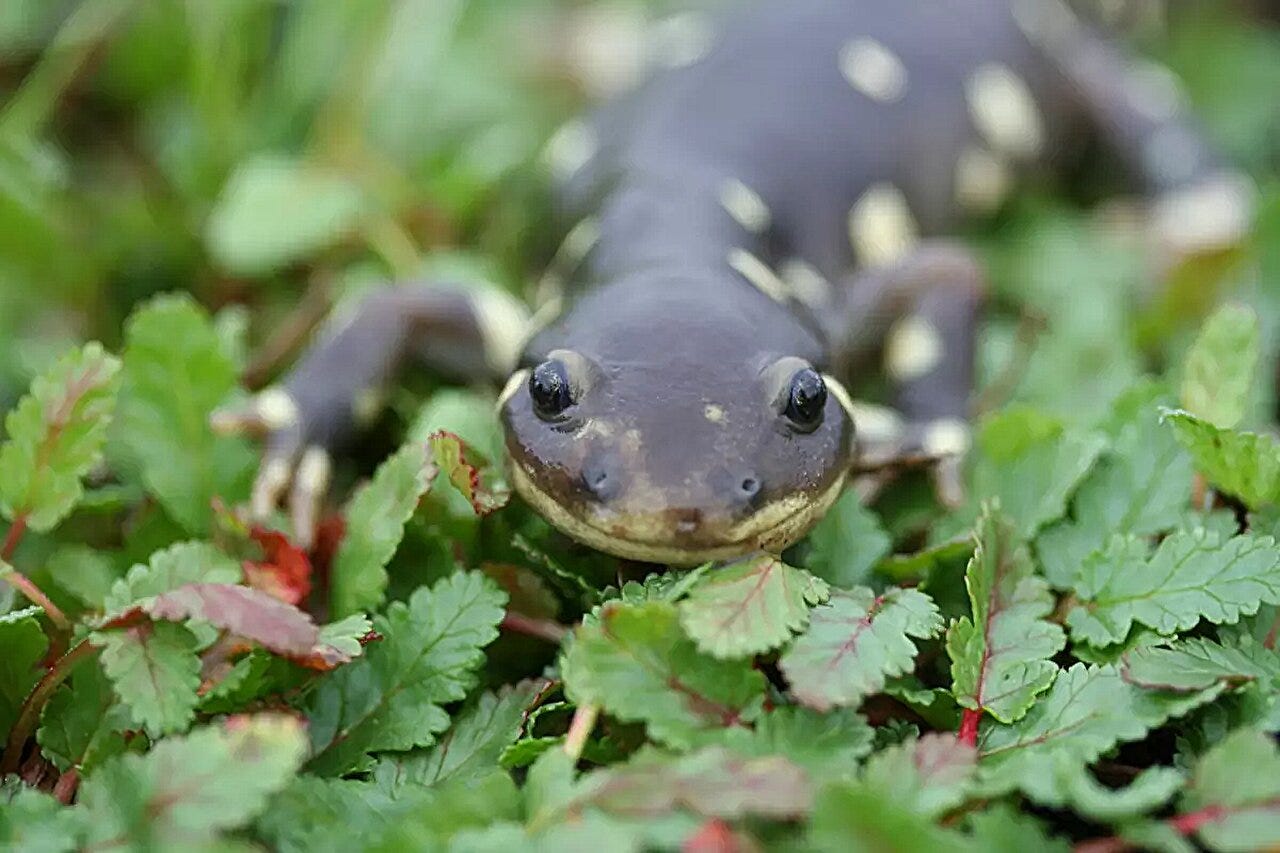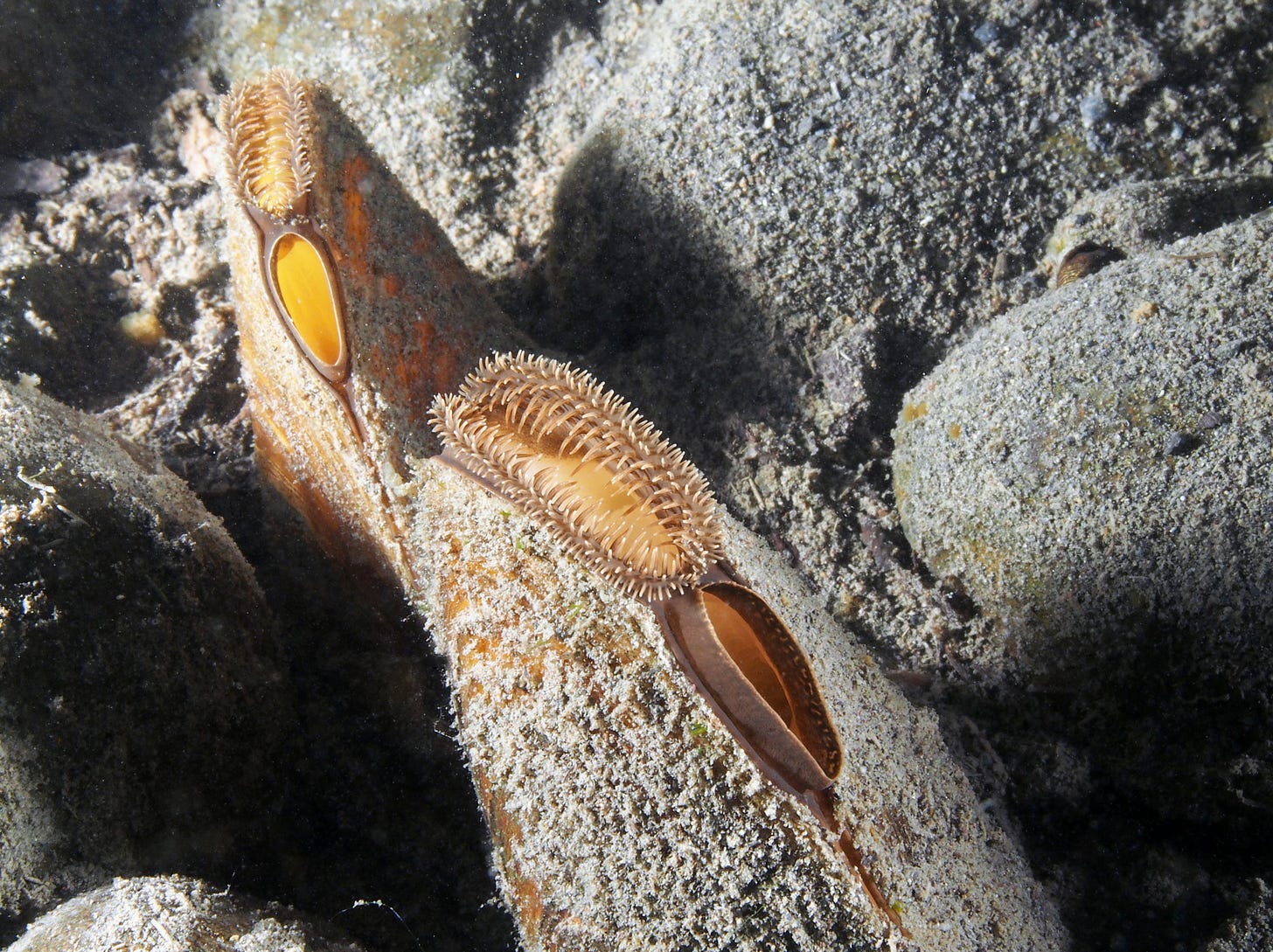Hello everyone:
As you’ll read below, I’m not big on New Year’s resolutions. But if you’re thinking about it, here are two good ones: Buy less stuff, and give away some of what you have. As Michael Coren in the Post’s Climate Coach column explains,
Each product we buy, on average, accounts for roughly 6.3 times its weight in carbon emissions. Together, our household purchases of goods and services account for between 26 and 45 percent of global greenhouse gas emissions. That’s heavily skewed toward the richest 1 percent of the world’s population which emits two times more than the poorest 50 percent.
As always, please remember to scroll past the end of the essay to read some curated Anthropocene news.
Now on to this week’s writing:
New Year’s has always felt like a weird holiday. Flipping the page in the calendar has some meaning for me, certainly, since it’s hard to escape the linear sense of time that drives western civilization. In my 50s now, I wrestle with time and its loss just like anyone else. Decades go by as years once did. The body aches, the horizon looms… But New Year’s parties and celebrations have always felt like I was participating in someone else’s fiction. What am I celebrating, and why?
This was true even when I was young and watching friends chant their way through the midnight countdown. Then, after years in the timeless landscapes of Antarctica, calendars felt about as relevant to my sense of time as a wristwatch does to a dog. I still prefer to sniff my way through the seasons.
Nor have I ever been one for resolutions. Maybe it’s a lack of discipline, but I’ve never felt compelled to make life decisions based on the artifice of January 1st. In this moment of resolution-making, though, I’ve been thinking about them at the same time I’ve been thinking about the 50th anniversary of the Endangered Species Act, arguably the most important step the United States ever took to care for the more-than-human world.
Policies are promises, after all. They’re resolutions with a paper trail.
We usually describe resolutions as goals, but often they’re a promise to set new baselines. We’re drawing a line in our mental sand, saying the bad habit ends now, or things will not get worse than this. The Endangered Species Act falls into this category, certainly: We will not let these populations of highly-evolved life disappear from the Earth because of our actions.
The Endangered Species Act (ESA) was signed into law under President Nixon on December 28th, 1973, at the height of American environmental passion. Rachel Carson had published Silent Spring a decade earlier. Unchecked industry and growth had ravaged both urban and rural landscapes. Some 20 to 25 million people hit the streets for the first Earth Day in 1970 – the largest single-day protest in American history – and environmentalism was, for a shining moment, a fully bipartisan cause.
Nixon was likely more opportunist than tree-hugger, but under his pen the U.S. wrote into being the Clean Air Act, the Clean Water Act, the National Environmental Policy Act, the Marine Mammal Protection Act, the National Oceanic and Atmospheric Administration, and the Environmental Protection Agency. When the ESA came up for a vote, the Senate approved it unanimously and only four members of the House voted against it.
Imagine a similar vote happening today.
84% of the American public still supports the law, according to a recent survey by Defenders of Wildlife. (The poll also found that 80% of respondents support fully funding the ESA and 67% believe that protecting biodiversity should be a national priority.) But while the ESA may be the backbone of U.S. conservation policy and a darling of the American public, the fossil fuel, agriculture, and mining industries (and their political agents) have been gnawing at it for decades. The gnawing has grown much worse recently. But before I get into that, I want to convey the remarkable successes and troubling weaknesses of the ESA.
It’s a fairly simple and brief statute, as federal rules go, all packed into a PDF of fewer than 50 pages. Its purpose is use the coordinated efforts of federal agencies to protect against the “take” – killing, hunting, harming, collecting – of listed species. In a current National Geographic article on the ESA, photographer Joel Sartore describes it in terms of holding the line against severe biodiversity loss:
I often think about saving endangered species as like making sure all rivets in an airplane wing are secure. If we lose one or two, it wouldn’t affect your flight across the ocean. If you start losing dozens, you’ll get nervous and look for a parachute. But there’s no parachute for this. It’s the only planet we have.
Sartore has spent many years making beautiful and intimate studio photographs of wildlife (15,325 species so far) in his remarkable Photo Ark project. These include nearly 700 endangered and threatened species, including rare big cats and other large charismatic animals. But I was happy to see that when asked what species he thinks of in terms of U.S. biodiversity loss, Sartore first mentions freshwater mussels. (Some of you will recall my essay on the lessons we can learn from freshwater mussels, “The Liver of the River.”) They’re beautiful and fascinating animals – they filter up to 15 gallons of water per day, have weird sex lives and great names, and can live a hundred years – and they’re vitally important species for freshwater quality and ecology.
And they’re disappearing. Frequently described as “one of the most imperiled groups of animals in the world,” more than a third of the 302 North American mussel species are extinct or in danger of extinction, with over 75% of remaining species listed as endangered, threatened, or of special concern.
The survival of the remaining species, if indeed they survive, will rely to a large extent on the full support of the ESA.
The US Fish and Wildlife Service, which (with the National Marine Fisheries Service) is the primary administrator of the ESA, summarizes the legislation in a long awkward bureaucratic paragraph. I’ll break it into bullet points. The Endangered Species Act
establishes protections for fish, wildlife, and plants that are listed as threatened or endangered;
provides for adding species to and removing them from the list of threatened and endangered species, and for preparing and implementing plans for their recovery;
provides for interagency cooperation to avoid take of listed species and for issuing permits for otherwise prohibited activities;
provides for cooperation with States, including authorization of financial assistance;
and implements the provisions of the Convention on International Trade in Endangered Species of Wild Flora and Fauna (CITES).
So far, a remarkable 99% of the threatened and endangered species listed by the ESA have avoided extinction. 54 species have been fully delisted because their populations recovered sufficiently. Another 56 species have been shifted from the endangered list to the threatened list as their situations have improved. Often this means the protection of critical habitat (like a stretch of river inhabited by rare mussels) and all of its other species as well.
This last point is important to emphasize: the ESA focuses on individual species (or an isolated population thereof), but the salvation it provides extends to the communities of life that connect to that species. Save a salmon, and you enrich the river, forest, and ocean communities that surround it. Save an alligator, as the ESA did, and you rebuild the food web of its Florida wetlands. “Alligators really are almost like a poster animal for the Endangered Species Act,” Joe Roman, a conservation biologist and author of the book Listed: Dispatches From America’s Endangered Species Act, told a Mother Jones reporter. “Stop killing them, protect their habitat, and they will come back.”
These are promises we have kept, and lines in the sand we have not crossed. We made resolutions and kept them. The ESA remains the best tool we have in the U.S. for safeguarding the continued existence of many plants and animals.
And all of this has happened despite the agencies doing the work being chronically underfunded. One study found that per species funding has dropped 50% since 1985, and another determined that Congress only provides about 3.5% of the funding that USFWS scientists think is necessary.
But it’s important to admit the significant caveats to this success.
Much more would have been done these last 50 years if funding had been adequate. As noted above, USFWS have been working with pennies where dollars were needed. The state of wildlife in the U.S. would look much different today had the promise of funding been kept.
The ESA is emergency medicine, not preventative care. My reading on the ESA kept coming back to this point. Everyone doing conservation work is deeply grateful for the power and resilience of the ESA, but they bemoan its narrow focus on picking up species after they fall. As one of a flurry of recent Mother Jones articles on the ESA puts it,
While it’s considered an “emergency room” for endangered plants and animals—a last-resort law to protect species on the brink of extinction—it does very little to prevent them from landing in that emergency room. “The worst thing about the act,” Moore says, “is it’s waiting for things to get to the point where you’re in trouble.”
One exception to this flaw in the ESA is the benefit of protection that extends beyond the target species to the community around it. To whatever extent that protection shields other unlisted species of concern, it’s doing preventative work. But this is happenstance rather than directed care.
It takes way, way too long to list a species and develop a recovery plan. As another excellent Mother Jones article (“The Wolverine and the Waitlist”) details, the recent listing of wolverines is a success that may have come too late. Climate change and habitat fragmentation finally earned it a threatened listing in late 2023, but the first calls from scientists to list the wolverine came thirty years ago. Such a wait is by no means unprecedented.
The problem, from what I’ve read, is not often with the science or the scientists. It’s funding, it’s the bureaucratic roller-coaster between administrations with different priorities, and it’s the lack of political will to list species that will upset industry and their pocketed politicians. For these reasons and others, it’s common for a listing to take more than a decade.
That delay has been fatal for at least 47 species which, according to the Center for Biological Diversity, went extinct while waiting for a listing. And, as Mother Jones reports, “hundreds of species are still waiting: As of April, more than 300 species sit on the federal government’s “workplan” for listing or designating habitat protections.”
In fact, the USFWS delisted 21 species from the ESA this year because they have been determined to be extinct. Uncounted millennia of evolution die with each of these lineages, and their place in the living fabric is now a hole that no other species is fit to fill. “It’s a horrible tragedy,” the ecologist and author Carl Safina told the Guardian. “And I think it is a breach of our moral guardrails.” A conservation biologist at the Center for Biological Diversity told the Guardian that in many cases these extinctions were at least partly caused by an ESA listing that came too late. On a personal level, she said, she was so moved by these losses that she and a colleague wrote eulogies for each species and held a wake.
For an excellent illustrated glimpse of fifteen sample species who have suffered from extended wait times, check out “The Wolverine and the Waitlist.” The examples are separated into three categories: those that finally got listing, those still waiting, and those which went extinct while waiting. Here’s an example of the latter:
The ESA is not designed to cope with accelerating climate change or a fast-moving extinction crisis. There were 124 species on the original 1973 list. There are now 2367 listed species, only 1379 of which have active recovery plans. And an honest glance at the Anthropocene horizon tells us that the list should be much, much longer.
Why? Because we live on the cusp of a biodiversity crisis unlike anything the Earth has seen since an asteroid wiped out the dinosaurs (and much of other life). To be clear, we are not yet in a mass extinction, but that’s the path we’re on. Wildlife populations have declined by nearly 70% since 1970 (three years before Nixon signed the ESA into law). The most recent analysis suggests that two million species across the globe are at risk of extinction. A hotter, more turbulent world has arrived, and human resource use has not yet begun to shrink to responsible levels. Meanwhile, we’ve probably only identified about one out of four or five species on the planet, which means we really, really should be protecting habitats rather than species.
The need for the Endangered Species Act has only grown, but its capacity to meet the need is in question. We need to make our promises and resolutions to the community of life rather than to individual plants and animals.
How should we move forward, then, toward all that awaits us? And by us, I mean the living world, ourselves, and our promises. That’s what I’ll talk about next week, but I’ll do so in the context of the range of threats to the ESA now embedded in the physical world and the American political circus.
Until then, I highly recommend you read the collection of topnotch stories on the ESA published by Mother Jones recently. The intro to the collection is “Endangered,” and the separate investigations are The Alligator and the Handbag, The Pronghorn and the GOP, The Venus Flytrap and the Golf Course, The Toad and the Geothermal Plant, The Wolverine and the Waitlist, The Elephant and the Gilded Cage, The Mussels and the Border Buoys, and Five Big Ideas for Improving the Endangered Species Act.
Here in Maine the first real snowfall of the year is arriving this weekend. Heather and I are excited for it, though the forecast also suggests that the snow is likely to be washed away in another weirdly warm northeaster next week. We’ll see, but certainly snow and ice are increasingly good candidates for the endangered list.
And finally, just because I want to leave you with something wonderful in the depths of winter, here is our good friend Jud Caswell, a truly extraordinary singer-songwriter, singing his arrangement of the Robert Frost poem, “Stopping by Woods on a Snowy Evening,” from which the title of this essay is borrowed. There’s much to be said about the meaning of the poem, but for now let’s rest on the simple ideas that the woods are lovely, and that we have a long way to go to keep our promises.
Stopping by Woods on a Snowy Evening
Whose woods these are I think I know. His house is in the village though; He will not see me stopping here To watch his woods fill up with snow. My little horse must think it queer To stop without a farmhouse near Between the woods and frozen lake The darkest evening of the year. He gives his harness bells a shake To ask if there is some mistake. The only other sound’s the sweep Of easy wind and downy flake. The woods are lovely, dark and deep, But I have promises to keep, And miles to go before I sleep, And miles to go before I sleep.
Thanks for sticking with me.
In other Anthropocene news:
From Reasons to Be Cheerful, “The Year in Cheer: 177 Ways the World Got Better in 2023,” a list (with links) from articles the upbeat site (created by David Byrne of the Talking Heads) has run this past year. These good news stories range from the small and local (“In Lagos, Nigeria, 115 students are paying their school tuition with recyclable plastic bottles instead of cash”) to the national (“Eighty percent of new cars sold in Norway are electric”) to the global (“The ozone layer will be completely recovered within the next 40 years”). Check it out if you need a serious diet of good news.
From Nautilus, a really wonderful list of the editors’ 25 “most beautiful” science stories of 2023. These are not your usual pop-culture science topics, but the kind of fascinating stories that Nautilus specializes in: The similarity of science to religion, despite all protests to the contrary; a scientific argument against free will; the oceans’ “garbage patches” are actually ecosystems; the consciousness of plants; and the scientific precision of Cormac McCarthy’s art.
From the Guardian, 2023 was the year that climate change hit Antarctica so hard that climate scientists felt it like “a punch in the guts.” Here’s a partial litany: The decline in sea ice formation was the size of Europe; the increase in glacial meltwater is slowing down the currents that drive global ocean and climate systems; the collapse of the West Antarctic ice sheet looks inevitable; East Antarctica had a heat spike that was a hundred degrees above normal; and Emperor penguin chicks died en masse. I’ll be sure to write about all this sometime this year.
Also from the Guardian, how Uruguay has revolutionized its power grid with renewables in little more than a decade. The country has nearly phased out fossil fuels and replaced them with wind and hydro.
The Climate Action Tracker provides a very detailed country-by-country analysis of how badly every nation on Earth is failing to meet their 1.5°C Paris Agreement target. Scroll down to the world map and click on your nation of interest to get an incredibly thorough assessment of government action and inaction.
From Yale e360, the quandary of dealing with species’ names (common or Latin) which are deemed offensive.
From Grist, the federal $7500 incentive for buying a new electric vehicle (and $4000 for a used one) has become an upfront discount rather than just a tax break. These are income-eligible incentives, so if a few thousand will make the difference in your decision to buy a new car, you’re in luck.
From CNN, the ice cover in the Great Lakes at the start of 2024 is, not surprisingly, lower than it’s ever been at this time of year. It’s almost nonexistent, in fact. Just 0.35% of the lakes have ice, down from the 10% historical average. Ice around the globe is in rapid decline, and if unchecked the ecological changes linked to that loss will be one of the major factors shaping the Anthropocene.
From the Union of Concerned Scientists, a thorough assessment of the state of wetlands protection in the U.S. The Supreme Court, in its ridiculous Sackett decision, eliminated longstanding protection for 2.5 million acres of wetland habitat across the country, at a time when we need additional conservation, not less. There are ways to move forward, but mostly at the state level.








It's fascinating to note the contrasts here. A huge majority of Americans support properly funding the ESA...
and yet it's not adequately funded,..
and it's only acting on the downstream effects, not the causes.
All of this makes me think: in their hearts, people know what the right thing to do is: properly protect biodiversity. I'd go further and say that in their hearts (perhaps without realizing it) they know the proper role humans should play as part of nature - regenerating not extracting.
Which all points to where the real work is to be done: changing the culture. We've got to go deep - to the causes, which are historical, spiritual, psychological - otherwise we're just using band-aids or, worse, distracting ourselves from the serious, difficult work to be done.
Query to the interested:
Jason notes the (disturbingly large) number of species that have been delisted from ESA consideration and concern simply because they became extinct; it seems likely to me that many more species have suffered this fate than have been delisted because of successful implementation of the ESA. Anyone have the data? Is this perhaps true?